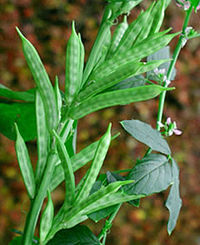
Photo from wikipedia
In the context of climate change, the Ivorian cotton industry is facing with the loss of sensitivity of pests (Helicoverpa armigera) and the appearance of new so-called emerging insects. Faced… Click to show full abstract
In the context of climate change, the Ivorian cotton industry is facing with the loss of sensitivity of pests (Helicoverpa armigera) and the appearance of new so-called emerging insects. Faced with this situation, cotton producers tend to use insecticide products in high doses, in excess of the norm. However, the misuse of chemical products poses many health risks. Therefore, to limit the use of chemicals, aqueous extracts of local plants with insecticidal properties were examined in the laboratory and in the field. Four local plant species were selected [Anacardium occidentale (Anarcardier); Azadirachta indica (Neem); Hyptis suaveolens (Hyptis) and Tephrosia vogelii (Tephrosia)]. After determining the chemical profiles of the four extracts by high performance liquid chromatography (HPLC)-mass spectrometry, their inhibitory activities were assessed in cholinesterase and tyrosinase. The sensitivity of Helicoverpa armigera larvae was evaluated by ingesting the aqueous extracts at several concentrations ranging from 2% to 64% in an artificial nutrient substrate. Then, the mortality rates of the larvae during 72 h were evaluated and the lethal concentrations were determined. The results of chemical analyses (HPLC) showed that the richest aqueous extract in phytochemicals with 54 elements detected was that of cashew (A. occidentale). T. vogelii, A. indica and H. suaveolens presented 44, 45, and 39 chemical compounds, respectively. In addition, the total phenolic content was higher in A. occidentale (110.67 mg gallic acid equivalents/g) followed by A. indica (42.43 mg gallic acid equivalents/g). The highest antioxidant ability was observed with the aqueous extract of cashew (A. occidentale). Anti-enzymatic activities such as acetylcholinesterase, butyrylcholinesterase and tyrosinase inhibition were most pronounced in A. occidentale (2.35 ± 0.02 mg galanthamine equivalent/g, 3.77 ± 0.01 mg galanthamine equivalent/g and 71.28 ± 0.07 mg kojic acid equivalent/g, respectively). The most toxic aqueous extract for H. armigera larvae was that of cashew with a lethal concentration LC50 = 11.68%. Moreover, the principal component analysis performed showed that the insecticidal activity is strongly correlated with the antioxidant and enzymatic activities of the aqueous extracts. Then, the hierarchical ascending classification showed cashew as the best plant. For the sustainability of cotton production, it would be necessary to limit the use of chemical-synthetic insecticides through the use of plant extracts, especially from cashew leaves.
Journal Title: Archives of insect biochemistry and physiology
Year Published: 2023
Link to full text (if available)
Share on Social Media: Sign Up to like & get
recommendations!